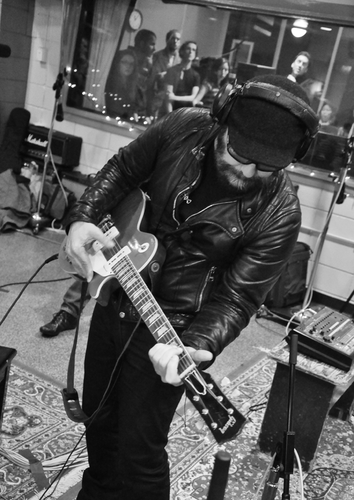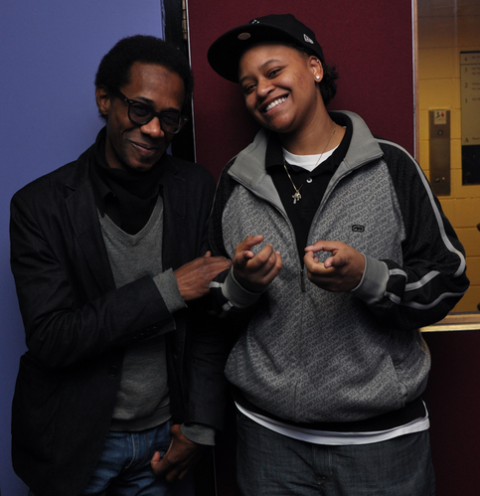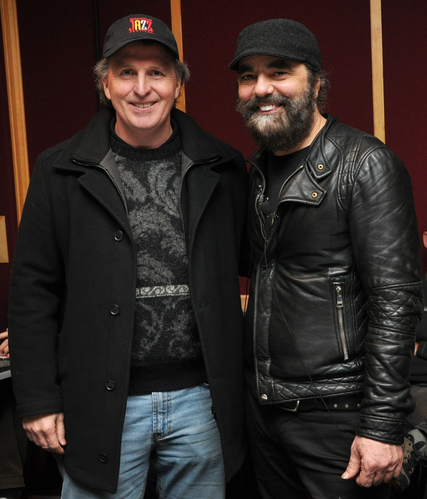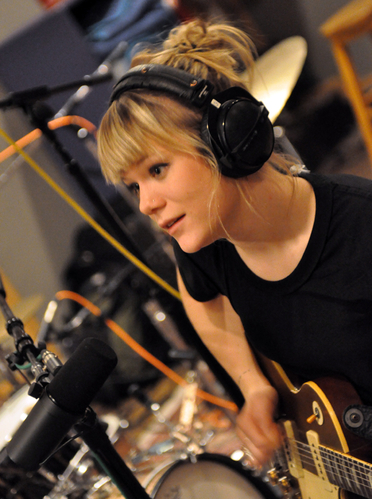Daniel Lanois in Studio A

Students watch Daniel Lanois take matters into his own hands at the November 18 recording session.
Photo by Phil Farnsworth

Drummer Brian Blade with Genesis Rubin, a music production and engineering major in her final year at Berklee.
Photo by Phil Farnsworth

Lanois works with student cellist Keith Dickerhofe to get the track precisely right.
Photo by Phil Farnsworth

Singer/songwriter Trixie Whitley shares her ideas for the cello part with Lanois.
Photo by Phil Farnsworth

Lanois (right) stands with Roger H. Brown, Berklee president.
Photo by Phil Farnsworth

Whitley wrote the song "I'd Rather Go Blind" only two days before recording it.
Photo by Phil Farnsworth
Daniel Lanois started his three-day residency at Berklee with a concert. He finished on November 18 exercising his famed producer muscles, by recording a song in Studio A with New York–based singer/guitarist Trixie Whitley, drummer Brian Blade, and a few Berklee stand-ins.
Lanois was no hands-off producer, to say the least. He stood right next to Whitley as she sang, "I ain't no weeping child." Headphones and black leather jacket on, he shifted back and forth to the beat. Before re-recording the guitar part, he tuned the Les Paul himself.
The song, "I'd Rather Go Blind," had a cool but passionate bluesy twang. "Very, very cool drum sound," he said at the mixing board, listening to the results and playing air bass. "Rock and roll."
Rob Jaczko, coengineer and chair of the Music Production and Engineering Department, thought students "learned an enormous number of things. They saw his intensity and single-minded focus... [his] undivided attention to the artist and focus on the song."
Whitley herself was surprised. "I just wrote this song two days ago. I'm just hearing it now," she said. "It's cool, because I had no idea where this could go."
"It's just an honor to have somebody come here and invest this kind of time with students," said Berklee president Roger H. Brown, stopping in for a minute. "The whole process revealed... it's a really generous thing."
In fact, Jaczko said, Lanois jetted straight from Boston to a recording session with U2.
However, the producer didn't seem to have anything in his head other than the work immediately at hand. Only briefly did he uncoil enough to notice that there were "a lot of people in the control room. This is like a Rolling Stones session! We [just] need a few more girls."
Despite the lack of formality, the pressure was on. Cellist Keith Dickerhofe came up the tiniest hair sharp on an ascending run. Not every time—only twice in six, Lanois noted.
Jaczko credited Lanois's diplomacy and sensitivity in the situation, noting he tried to "encourage him and give him the tools to find the tuning himself."
Rather than immediately resorting to technological magic, Lanois ran Dickerhofe through countless runs of the tricky passage before finally cutting and pasting a good go-round as a stopgap "band-aid," as he called it.
Experience had proven the merits of the analog approach. "I did an Emmylou Harris record with all live vocals," Lanois mused. She tried to record overdubs another day, but "they were never as good.... There was just something changing in the molecules."
Hear that day's chemistry on Whitley's MySpace page.
